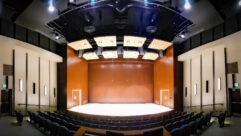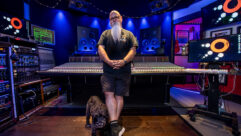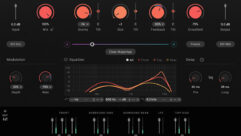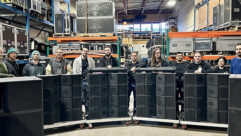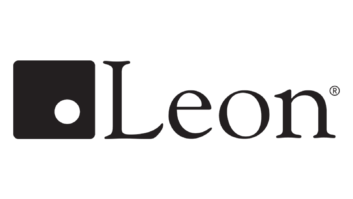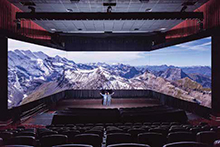

Immersive Picture and Sound: Immersive Format: Barco Escape
Dec 29, 2014 10:35 AM, By Jon Silberg
Barco Escape creates an immersive image without adding enormous costs to the content creation budgets.
In order to compete with the growing range and quality of home entertainment options, those in the cinema and leisure industries are looking for new ways to create compelling guest experiences.
Barco, the Belgian manufacturer of high-end digital cinema projectors, has been experimenting with a technology they call Barco Escape. The system, similar to Cinerama of the mid-20th century, is based on using three side-by-side projectors to create an extremely widescreen presentation– an immersive image designed to make the action on the screen seem to wrap around the audience. While the use of three strips of film made Cinerama famously unwieldy to shoot and project, the drivers of Escape believe that digital technology can alleviate most of those concerns, both in content creation and the display. Barco’s projectors can be adjusted for issues related to keystoning and contrast variation among the projectors in ways film projectors never could.
As a proof of concept, Twentieth Century Fox (the pioneers of CinemaScope more than six decades ago), commissioned in tandem with Barco the creation of special additional material to be shown in their Escape format for the studio’s young adult feature The Maze Runner this fall. Barco outfitted five Cinemark theaters in the US and two Kinepolis theaters internationally with the three-projector setup required to show it in its 6.5:1 aspect ratio (based on a center projector with the anamorphic image and two side panels at 1.78:1 with additional CGI material created especially for this presentation).
Ted Schilowitz is a “cinemavangelist” for Barco and “futurist” for Fox (and former principal at Red Digital Cinema). He oversaw both the creation of the additional CGI material for the side screens and the outfitting of the selected theaters with the projectors and server technology required to display the scenes in Escape. Schilowitz acknowledges that the Maze Runner presentations were an experiment, not a final “product.” “We’re essentially trying to break out of the rectangle,” he declares. “We want to build an experience that is not like what we’ve seen in traditional cinema–more like what you see in major theme parks. They are really the places that have focused on the future.”
A veteran of the cinema production and post industries, Schilowitz, stresses that the Maze Runner presentations were part of an ongoing process for Barco and Fox to test the waters. Stakeholders needed to get some idea how that extra screen real estate could be filled in at Escape theaters without requiring filmmakers to commit to that extremely wide aspect ratio and without adding enormous costs to the content creation budgets. And of course, they wanted to see how audiences would react to the Escape format.

For Maze Runner, Schilowitz tapped an LA-area visual effects company, Box Creative, to create the additional material. They built digital animation using many of the film’s original visual effects assets, rendering the results out using technology designed for videogame engines, rather than using a standard workflow. The experimental technique, “let us do more VFX shots more quickly and more cost-effectively than would ever be possible otherwise,” says Box Creative’s president Jason Chen.
The actual presentation itself, which is based on adding an extra screen on either side of the theater’s main screen, could evolve too, says Schilowitz. For example, it some point it could be replaced by a single, extra-wide curved screen without the seams that were part of the Maze Runner showings. Escape might turn out to be better suited to alternative content than to feature films; to test that hypotheses the company will be rolling out a concert film in Escape using material shot specifically for the format during a recent performance by Lady Gaga and Tony Bennett in Brussels. That project was shot with 14 6K Red Epic cameras and the Escape presentation will make use of some panorama images designed to fill the entire wide ultra wide screen.
“This is part of a constant push-and-pull between what audiences can see at home today and what will make them want to go to a movie theater,” Schilowitz sums up. “The home experience is a really good experience compared to what it was just 10 years ago. So how do you make going out to a movie hyper-compelling? The one thing we know for sure is that if we stay where we are today, movie theaters will continue to see dwindling attendance.”
And if new experiences succeed in the multiplex, will theme parks, concerts and specialty venues need to up their game again, to stay ahead of the multiplex? Will more “off the shelf” options like Escape allow lower budget venues to better compete with Universal Studios? Stay tuned.



